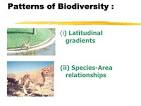Studies have shown reasons for vary in biodiversity pattern across the globe. Biodiversity is not evenly distributed, and it varies greatly across the universe as well as within regions. other factors are, the diversity of all living things “biota” depends on soil, temperature, altitude, appreciation, geography and the presence of other species. And the study of the spatial distribution of organisms, species, and ecosystems, is called the science of biogeography. This uneven distribution in biodiversity pattern did not just manifest but it has a result of several factors.
Reasons for the massively increased level of biodiversity at the tropics are explained as follows :
:
The Tropical areas have a more predictable climate compared to the temperate areas. Therefore, the tropics succeed in supporting a higher number of species as the species do not have to keep adapting to a changing season.
The Temperate regions have suffered a lot of glaciations in the recent past because they have had a very unstable environment. In which, the tropics have been comparatively reliable. Though, speciation has been more favored in the tropics compared to that of the temperate lands.
The tropical regions are comparatively more influence by solar energy. Because of this, the plants in this region receive more energy during photosynthesis. This, in turn, gives more energy to the successive trophic levels in the food chain. Though, more energy supports more diversity.
Species-Area relationships – The great German naturalist and geographer, called Alexander von Humboldt discover that the relation between an area and the species richness found in it. He discovered that as he increased the area of observation, the plant and animal diversity increased but up to a certain stage.
Latitudinal Gradients in Pattern of Biodiversity

There is a massive increment in biodiversity from the poles to the tropics. Though, the localities at lower latitudes carry more species than localities at higher latitudes. This is often called the latitudinal gradient in biodiversity pattern. Some ecological factors also contributed to the gradient, but the paramount factor behind many of them is the greater mean temperature at the equator compared to that of the poles.
Though terrestrial biodiversity decreases from the equator to the poles, some findings claim that this characteristic is unverified in the aquatic environment, especially in marine ecosystems. The distribution of parasites does not appear to follow this principle. The ecosystem determines the pattern of biodiversity as the climatic factor is essential.